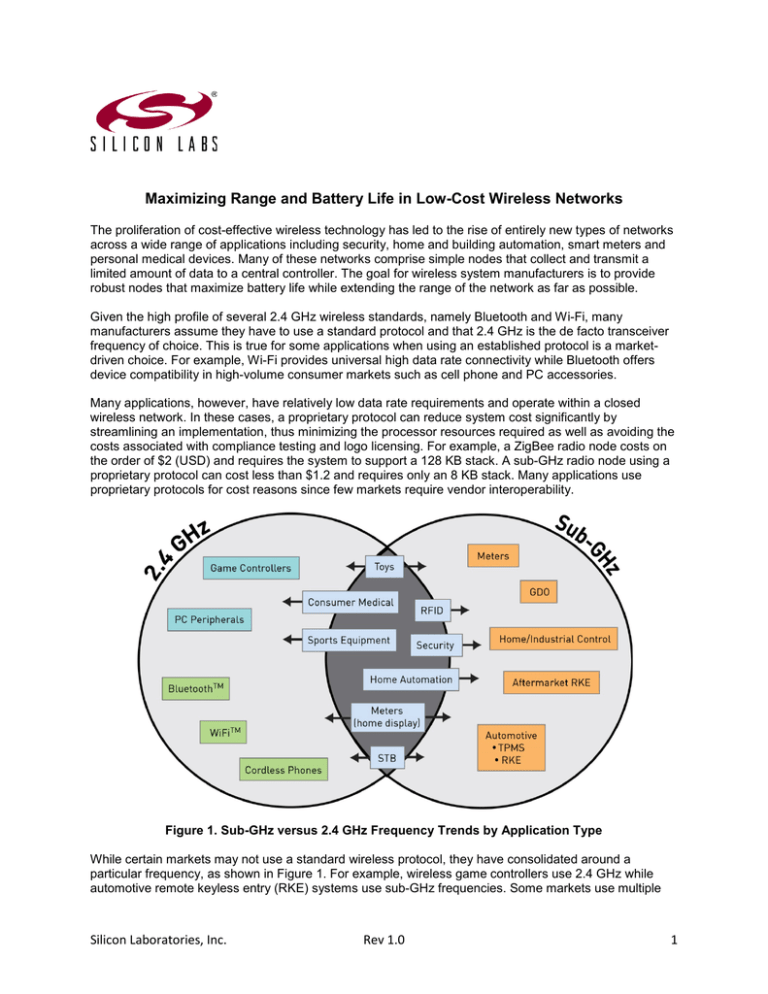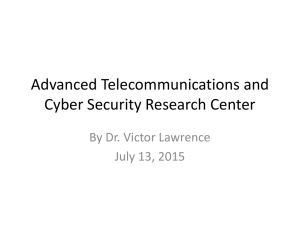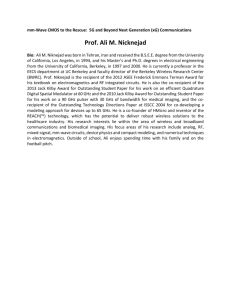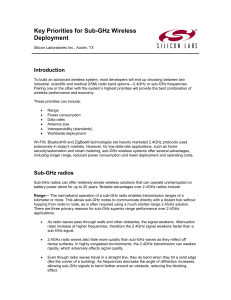Maximizing Range and Battery Life in Low-Cost
advertisement

Maximizing Range and Battery Life in Low-Cost Wireless Networks The proliferation of cost-effective wireless technology has led to the rise of entirely new types of networks across a wide range of applications including security, home and building automation, smart meters and personal medical devices. Many of these networks comprise simple nodes that collect and transmit a limited amount of data to a central controller. The goal for wireless system manufacturers is to provide robust nodes that maximize battery life while extending the range of the network as far as possible. Given the high profile of several 2.4 GHz wireless standards, namely Bluetooth and Wi-Fi, many manufacturers assume they have to use a standard protocol and that 2.4 GHz is the de facto transceiver frequency of choice. This is true for some applications when using an established protocol is a marketdriven choice. For example, Wi-Fi provides universal high data rate connectivity while Bluetooth offers device compatibility in high-volume consumer markets such as cell phone and PC accessories. Many applications, however, have relatively low data rate requirements and operate within a closed wireless network. In these cases, a proprietary protocol can reduce system cost significantly by streamlining an implementation, thus minimizing the processor resources required as well as avoiding the costs associated with compliance testing and logo licensing. For example, a ZigBee radio node costs on the order of $2 (USD) and requires the system to support a 128 KB stack. A sub-GHz radio node using a proprietary protocol can cost less than $1.2 and requires only an 8 KB stack. Many applications use proprietary protocols for cost reasons since few markets require vendor interoperability. Figure 1. Sub-GHz versus 2.4 GHz Frequency Trends by Application Type While certain markets may not use a standard wireless protocol, they have consolidated around a particular frequency, as shown in Figure 1. For example, wireless game controllers use 2.4 GHz while automotive remote keyless entry (RKE) systems use sub-GHz frequencies. Some markets use multiple Silicon Laboratories, Inc. Rev 1.0 1 wireless technologies. Automated utility meters, for example, use sub-GHz as a long-range wireless backhaul network and 2.4 GHz for meter-to-home communications. Home security systems use sub-GHz for low data rate sensors and 2.4 GHz for high data rate video cameras. Some markets remain undecided when it comes to wireless protocols. For example, existing home automation systems use sub-GHz frequencies while emerging 2.4 GHz/ZigBee devices are entering the market. Wireless developers must determine whether a sub-GHz or 2.4 GHz transceiver will best serve their application needs. Transceivers based on 2.4 GHz offer high data rates (greater than 1 Mbps) and a small antenna (less than one-third the size of a 900 MHz antenna), which makes for a good fit with shortrange consumer electronics devices. However, a 2.4 GHz radio has limited range – environmental losses are ~9 dB more than at 900 MHz. The high data rates require a wider receiver channel bandwidth, which further limits the sensitivity and range. A 2.4 GHz radio also has higher power consumption due to reduced circuit efficiencies. In addition, the 2.4 GHz spectrum is crowded and subject to significant interference from Wi-Fi devices, Bluetooth nodes and microwave ovens. In contrast, sub-GHz radios offer substantially higher range than 2.4 GHz radios, on the order of kilometers. Sub-GHz radios also enable low power consumption and can operate for years on a single battery. These factors, combined with low system cost, make sub-GHz transceivers ideal for low data rate applications that need maximum range and multi-year operating life. One of the disadvantages often aimed at sub-GHz wireless designs is that the antennas are larger than those used in 2.4 GHz designs. The antenna size for 433 MHz applications, for instance, can be up to seven inches long. Antenna size and frequency are inversely proportional as shown in Figure 2. If node size is an important design consideration, developers can raise the frequency (up to 950 MHz, for example) and employ a smaller antenna. Figure 2. Antenna Size and Frequency Are Inversely Proportional Another factor to consider is where a product will be sold and deployed. The 2.4 GHz band has the advantage of enabling one device to serve in all major markets worldwide since the 2.4 GHz band is a global spectrum. However in reality, this advantage is often overstated. Each country has different regulations that can force manufacturers to certify products for specific countries as well as provide regional SKUs. Developers need to understand these regulations early in the design process to avoid costly late-cycle redesigns. For many applications, 433 MHz is a viable alternative to 2.4 GHz for most of the world, and designs based on 868 and 915 MHz radios can serve the US and European markets with a single product. Table 1 shows a summary of the key factors for deciding between sub-GHz and 2.4 GHz. In general, high data Silicon Laboratories, Inc. Rev 1.0 2 rate applications will need a 2.4 GHz radio. For long-range, low-power applications, a sub-GHz transceiver often provides the optimal approach. Table 1. Summary of Key Factors between Sub-GHz and 2.4 GHz Solutions Key Factor Strength Comments Range Sub-GHz Higher regulatory output power, reduced absorption, less spectral pollution, narrowband operation. Power consumption Sub-GHz Better circuit efficiency, improved propagation at sub-GHz. 2.4 GHz chips performance much lower. Software cost Proprietary Small stack sizes, targeted applications. Multi-vendor Sub-GHz 2.4 GHz Most standards are at 2.4GHz (due to global frequency); Many sub-GHz standards are also available. Worldwide deployment 2.4 GHz 433 MHz 2.4 GHz has an advantage. 433 MHz can be used in most of world except Japan. Same 868 MHz/915MHz designs for most of world. Antenna size 2.4 GHz Smaller antennas optimal with 2.4 GHz; however very small designs can be achieved in sub-GHz. Data rate 2.4 GHz Much higher throughput can be achieved. Operating Range Battery lifetime is a critical design constraint in many wireless networking applications since many wireless nodes are typically battery-operated and need to operate for months or years without maintenance. Optimizing battery life, however, requires that developers look beyond the efficiency of the transceiver. Operating life for a sensor node also depends on the node’s range, radio sensitivity, data rate and the number of nodes in the network. For many sub-GHz applications, range is unquestionably the most important design constraint, making this a straightforward determination. Increasing the transmit output power extends the range and coverage but consumers more battery power. Greater range can result in lower system cost since the longer a node’s range, the fewer nodes there need to be in the system to provide complete coverage of an area. For example, in a lighting automation system, nodes must be able to communicate with the central controller from any room in the house or building. A node with limited range will present deployment issues, which could increase installation difficulties that result in expensive customer service support calls, product returns and lost revenue. To achieve sufficient building coverage, a node must be able to transmit at more than 10 dBm. For larger locations such as warehouses and campuses, 10 dBm will be insufficient to reach across the entire target site. As a result, more nodes will be required to achieve complete coverage. In addition, multiple controllers may be needed throughout the site, significantly increasing system complexity and requiring expensive manual configuration during installation. Silicon Laboratories, Inc. Rev 1.0 3 Sub-GHz transceivers such as Silicon Labs’ EZRadioPRO ICs provide greater output power to support transmissions up to 20 dBm. While the output power can be scaled down from 20 dBm to match the optimal range, increasing the maximum output power available at each node can ensure that there is sufficient margin to provide the desired range. After all, if a node cannot reach the central controller, it doesn’t matter how power efficient it is. In addition, greater range potentially reduces the number of nodes required in a mesh network to achieve complete coverage. The need for fewer nodes in turn minimizes system cost while increasing system robustness and efficiency by reducing contention for shared bandwidth between nodes. Even if range is not an issue, many wireless system manufacturers will consider operating at a higher output power to overdrive the antenna. In this way, the range requirements of an application can be met with a less expensive, inefficient antenna, resulting in lower system cost. Having high output power as an option gives manufacturers the flexibility to decide this tradeoff for themselves. Sensitivity and Longer Battery Lifetime Range is determined by the sensitivity of the transceiver and its output power, commonly referred to as link budget. A primary factor affecting radio sensitivity is the data rate. The lower the data rate, the narrower the receive bandwidth is and the greater the sensitivity of the radio. Figure 3 shows how sensitivity is higher at lower data rates. Note that as sub-GHz radios are able to support a narrower channel bandwidth than 2.4 GHz radios, they can more accurately and efficiently reflect the transmission needs of low data rate applications, as well. Sensitivity SensitivityvsvsDatarate Data Rate Sensitivity (dBm) -95 -100 -105 -110 -115 -120 -125 1 10 100 1000 (kbps) DataDatarate Rate (kbps) Figure 3. Sensitivity Increases with Lower Data Rates Selecting the optimal data rate can involve a complex balance of choices. The higher the data rate, the less time the system needs to expend power when transmitting (i.e., a radio operating at 200 Kbps will need to be active approximately half the time compared to a radio operating at 100 Kbps.) A faster data rate also will enable more nodes to be co-located together without adverse contention. However, higher data rates reduce sensitivity, leading to a need for higher output power to achieve sufficient range. Ideally, developers want to select a low data rate that still provides sufficient system responsiveness while minimizing transmit time. Sub-GHz transceivers, such as Silicon Labs’ EZRadioPRO devices, support a programmable data rate. In the case of the latest EZRadioPRO ICs, developers can select data rates of up to 500 Kbps in 2GFSK Silicon Laboratories, Inc. Rev 1.0 4 modulation and up to 1 Mbps when using 4GFSK modulation. Because programmable transceivers can be configured to operate across a range of data rates, this allows developers to fine tune the data rate so the radio transmits for the least amount of time, while taking range and sensitivity into consideration. For many applications that require a low data rate, the “sweet spot” is 40 Kbps where the transceiver can still use a standard off-the-shelf 20 parts per million (ppm) crystal. To achieve a narrower channel range requires a low PPM crystal or temperature-controlled crystal oscillator (TCXO); either crystal option costs substantially more than a 20 ppm crystal. Developers also have the option of improving system robustness in sub-GHz designs through the use of frequency hopping. Silicon Labs, for example, offers several reference designs with and without frequency hopping to enable developers to maximize range with the available output power. These reference designs also take into account regulatory limitations that limit output power. Note, too, that the transceiver’s current consumption can greatly impact the system’s overall power consumption. Every transceiver offers a variety of active and power-down modes. The transmit/receive frequency of the node will determine which mode will have the greatest impact on power. For example, if a node is transmitting frequently, transmit power will be very important. Similarly, if a node transmits only once a day, shutdown efficiency will be the most influential factor. The availability of different standby modes also can help developers optimize battery lifetime based on the specific transmit/receive requirements of an application. For applications where responsiveness is critical, such as medical or industrial applications where alerts must be handled as quickly as possible, the time-to-transmit/receive requires a standby mode with fast wake up. Silicon Labs’ Si446x EZRadioPRO wireless transceivers, for example, support standby power consumption of only 50 nA and features the lowest transmit output current for its output power. See Figure 4 for a detailed look at the ultra-low-power Si446x transceivers. Figure 4. Example of EZRadioPRO Wireless IC Architecture Silicon Laboratories, Inc. Rev 1.0 5 Network Topologies and Node Intelligence Battery lifetime can also be affected by the total number of nodes in the network. If there are hundreds of nodes competing with each other to communicate with the controller, there will be a significant number of collisions and retries depending upon the frequency of communication. Even if there is sufficient bandwidth to carry all of the data these nodes have to transmit, the wasted power expended upon retries can exceed the power required to send the data itself. Evaluating contention issues is an important step in designing a robust sensor node network. For example, if each node only needs to send a few bytes twice per day, the transmissions of hundreds of nodes can be staggered to result in little to no contention. However, if each node needs to constantly update the controller with a long stream of data, even a few nodes will generate substantial contention if the data rate is too low. Contention can be alleviated in a number of ways. Reducing the transmission frequency, possibly by buffering data for longer periods of time, can eliminate contention since each node will attempt to transmit less frequently. Alternatively, data packet size can be reduced through various compression techniques (i.e., send a 4-bit delta based on the last value sent rather than an absolute 8-bit value) or by employing more intelligence in the node through a microcontroller (MCU). For example, when captured sensor values are within an acceptable range, only a simple status flag is sent. Contention can also be reduced by increasing the data rate when other methods are insufficient. The network topology also impacts the battery life. Consider a star network where every node talks directly to the central controller. This is an effective and robust wireless network topology since every node is within range of the master. The disadvantage of this type of network is that as it becomes larger, the controller can become a bottleneck. In addition, the data rate needs to be high enough to accommodate data transmissions from every node as well as account for contention that arises. At some point, contention can overwhelm the network. Depending upon the network, this number could be as low as 16 to 32 nodes. A mesh network – where nodes interconnect with each other and data can pass through several nodes to reach the central controller – offers the most flexibility and can support a larger network over a greater physical area. Important attributes of any mesh network include automatic recognition of nodes as they are added to the network and self-healing as nodes are taken out of service. In general, transceivers are software and protocol agnostic since the radio driver on the MCU can be adjusted to support most existing software stacks. With its wide spectrum of options, control software should be selected based on range, the size of network, and the application functionality that needs to be supported. Silicon vendor-supplied code will suffice for small, simple networks regardless of topology. For example, Silicon Labs offers complementary, royalty-free EZMac control software to support basic sensor networks up to 128 nodes. For larger networks of hundreds to thousands of nodes, robust software is available from third parties offering a wide range of advanced features. For simple sensor-based networks, wireless MCUs such as Silicon Labs’ Si10xx devices, which integrate a sub-GHz transceiver with an MCU (see Figure 5), enable developers to implement the entire system with a single SoC, resulting in longer battery life, lower system cost and a more compact form factor compared to multi-chip implementations. For new designs, a wireless MCU enables developers to optimize both the radio and control code using the same set of tools, simplifying design and speeding time-to-market. To simplify manufacturing, mesh network protocol code can be embedded directly into the wireless MCU’s flash memory. When adding wireless capabilities to an existing design, it may be the case that a transceiver-only device is more cost-effective. Rather than having to port or redesign application code, developers can implement a protocol stack and interface to the radio onto the system CPU within a small footprint. Silicon Laboratories, Inc. Rev 1.0 6 Figure 5. Wireless MCU SoCs Integrate an MCU Core and Wireless Transceiver Today’s developers have a wide range of RF technology choices when developing low-cost wireless networks. The availability of 2.4 GHz radios using standard protocols facilitates interoperability for applications with open networks while sub-GHz radios provide a cost-effective approach providing long range and optimal battery lifetime. The combination of high power output, radio sensitivity and configurable data rate provides developers with the flexibility to optimize their implementation for range, cost, operating life and ease of installation. In addition, with a variety of network topologies and intelligent node firmware available, networks from a handful to thousands of nodes can be supported in a simple and robust manner. # # # Silicon Laboratories, Inc. Rev 1.0 7



